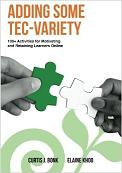

| Ed Tech Resources and Portals | Curt Bonk's Indiana University Homepage |
From: Professor Curtis J. Bonk, Indiana University
Contact: cjbonk at indiana.edu
|
Popular
Web 2.0 and related Technology Tools (mainly K-12):
1. E-Portfolio and Web Page Tools: (Personal webpage/portfolio: Google Sites: http://sites.google.com (like a wiki and a homepage—easy to change) 2. Document collab (Google Docs; http://docs.google.com/ and Google Presentations) 3. Share Docs and Slides (SlideShare: http://www.slideshare.net/). Online presentations. 4. Group collaboration (Google Groups: http://groups.google.com/, Yahoo Groups) 5. Wiki collaboration (Wikispaces: http://www.wikispaces.com/, Wetpaint: http://www.wetpaint.com/, PBworks (formerly PBwiki: http://pbworks.com/) 6. Blogging (Blogger: https://www.blogger.com/start, Word Press: http://wordpress.org/, Live Journal: http://www.livejournal.com/); Compare Blogger & Word Press: http://pulsed.blogspot.com/2007/07/blogger-wordpress-chart.html 7. Social networking (Facebook, Ning) e. g., Classroom 2.0: http://www.classroom20.com/; School 2.0: http://school20.ning.com/; Ning in Education: http://education.ning.com/ 8. Online photo sharing (Picasa: http://picasa.google.com/, Flickr: http://www.flickr.com/, Facebook: http://www.facebook.com/, etc.) 9. Podcasting (Audacity for PC: http://audacity.sourceforge.net/ and Garage Band for the Mac); also Gabcast (http://gabcast.com/) to create audio podcasting by using your phone or VoIP. Many podcasts in Education Podcast Network: http://epnweb.org/. 10. Shared online video: YouTube, TeacherTube (http://www.teachertube.com/), SchoolTube, TVLesson, NASA TV, Link TV (http://www.linktv.org/), YouTube Edu. 11. Concept Mapping tools (Gliffy, Mindmeister, Bubbl.us (http://bubbl.us/) 12.
Create
small cartoonish videos of animated characters: Xtranormal: http://www.xtranormal.com; 13. Social bookmarking (del.icio.us: http://delicious.com/), trailfire: http://trailfire.com/) 14. Finding online media (Odeo: http://odeo.com/) 15. Bookmarking websites and collaboration (Diigo); e.g., math resources: http://groups.diigo.com/groups/teaching-middle-school-math and science resources: http://groups.diigo.com/groups/teaching-middle-school-science), etc. 16. Communication (Skype: http://www.skype.com/, Google Talk: http://www.google.com/talk/ 17. Adding audio to Web content (Voice Threads: http://voicethread.com/) 18. Adding Audio to email (YackPack: http://www.yackpack.com/) 19. Screencasting to capture and instantly share your screen (Jing: http://www.jingproject.com/, Screenr: http://screenr.com/); with Screenr you can save your project as mp4 (ready for ipod/iphone), link to Twitter, post product on YouTube. 20. Collaborate on Math and Science Problems Online (Math Calculators like Instacalc: http://instacalc.com/ and http://my.instacalc.com/) 21. Webstreaming (UStream: http://www.ustream.tv/) 22. Video Creation (e.g., film a lecture or presentation by yourself from your laptop or desktop Web cam); VideoSpin: http://videospin.com/Redesign/) Windows Movie Maker: http://www.microsoft.com/windowsxp/downloads/updates/moviemaker2.mspx 23. Synchronous web conferencing (Vyer: http://vyew.com/site/, Dimdim: http://www.dimdim.com/) 24. Virtual Worlds: Second Life: http://secondlife.com/; Global Kids: http://globalkids.org/?id=30 25. Free Course Management Systems (Moodle: http://moodle.org/); Note: there is also free hosting of Moodle for basic installation: http://ninehub.com/ 26. Collaboration and Kids as Researcher Sites (BioKIDS, GLOBE, iEARN, ePals, etc.) 27. Various Web 2.0 tools: http://www.go2web20.net/ 28. Free and Open Access K-12 Contents and Courses: a. Curriki: http://www.curriki.org/xwiki/bin/view/Main/WebHome) b. National Repository of Online Courses: http://www.montereyinstitute.org/nroc/ c. Hippo Campus: http://www.hippocampus.org/ d. MIT Highlights for High School: http://ocw.mit.edu/OcwWeb/hs/home/home/
| ||||||||||||||
Copyright 2025, TrainingShare | Help | Comments | MOOCs and Open Education

